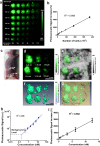Construction and validation of nano gold tripods for molecular imaging of living subjects
- PMID: 24495038
- PMCID: PMC3985880
- DOI: 10.1021/ja412001e
Construction and validation of nano gold tripods for molecular imaging of living subjects
Abstract
Anisotropic colloidal hybrid nanoparticles exhibit superior optical and physical properties compared to their counterparts with regular architectures. We herein developed a controlled, stepwise strategy to build novel, anisotropic, branched, gold nanoarchitectures (Au-tripods) with predetermined composition and morphology for bioimaging. The resultant Au-tripods with size less than 20 nm showed great promise as contrast agents for in vivo photoacoustic imaging (PAI). We further identified Au-tripods with two possible configurations as high-absorbance nanomaterials from various gold multipods using a numerical simulation analysis. The PAI signals were linearly correlated with their concentrations after subcutaneous injection. The in vivo biodistribution of Au-tripods favorable for molecular imaging was confirmed using small animal positron emission tomography (PET). Intravenous administration of cyclic Arg-Gly-Asp-d-Phe-Cys (RGDfC) peptide conjugated Au-tripods (RGD-Au-tripods) to U87MG tumor-bearing mice showed PAI contrasts in tumors almost 3-fold higher than for the blocking group. PAI results correlated well with the corresponding PET images. Quantitative biodistribution data revealed that 7.9% ID/g of RGD-Au-tripods had accumulated in the U87MG tumor after 24 h post-injection. A pilot mouse toxicology study confirmed that no evidence of significant acute or systemic toxicity was observed in histopathological examination. Our study suggests that Au-tripods can be reliably synthesized through stringently controlled chemical synthesis and could serve as a new generation of platform with high selectivity and sensitivity for multimodality molecular imaging.
Figures






References
-
- Rudin M.; Weissleder R. Nat. Rev. Drug Discovery 2003, 2, 123. - PubMed
-
- Ferrari M. Nat. Rev. Cancer 2005, 5, 161. - PubMed
-
- Weissleder R. Science 2006, 312, 1168. - PubMed
-
- Willmann J. K.; van Bruggen N.; Dinkelborg L. M.; Gambhir S. S. Nat. Rev. Drug Discovery 2008, 7, 591. - PubMed
-
- James M. L.; Gambhir S. S. Physiol. Rev. 2012, 92, 897. - PubMed
Publication types
MeSH terms
Substances
Grants and funding
LinkOut - more resources
Full Text Sources
Other Literature Sources
Molecular Biology Databases

